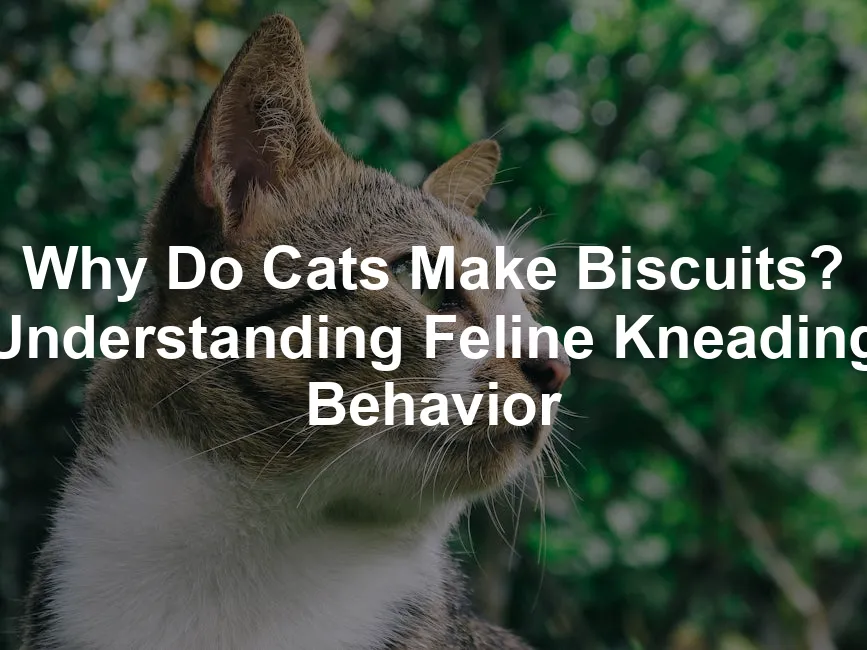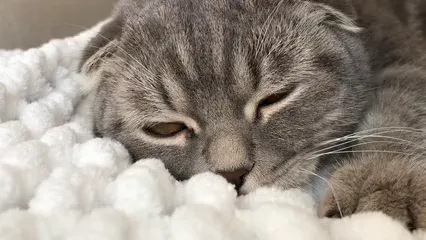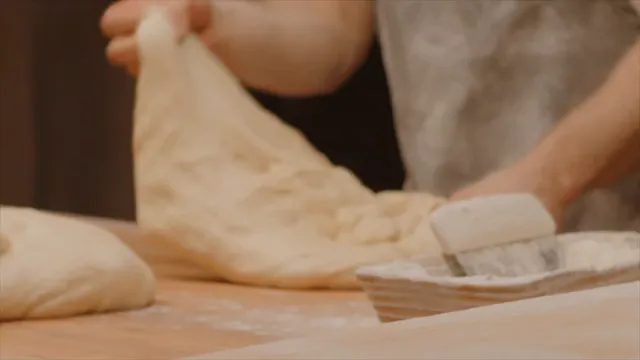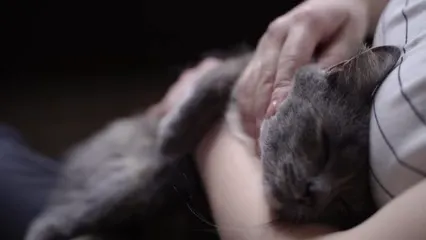
Why Do Cats Make Biscuits? Understanding Feline Kneading Behavior
Introduction
In the whimsical world of cat behavior, few sights are as endearing—and perplexing—as a cat kneading a soft surface with its paws. This charming ritual, affectionately dubbed “making biscuits,” can leave cat owners wondering if their furry friend is channeling their inner baker or simply expressing contentment. As your beloved feline rhythmically pushes and pulls their paws, they may be tapping into instincts rooted deep in their kittenhood or signaling their affection for you.
Kneading often looks like a cat is giving a massage, but it’s much more than that. This behavior links back to their early days, when they kneaded their mother’s belly to stimulate milk flow. It’s a nostalgic action that can bring your cat a sense of comfort and security. Watching a cat knead can be heartwarming, especially when they purr in delight, seemingly lost in their own cozy world. Yet, it can also be a little puzzling. Is your kitty just trying to get comfy, or are they marking their territory?
In this article, we’ll explore the fascinating reasons behind this peculiar behavior. From emotional bonding to territory marking, and everything in between, we’ll cover the many aspects of kneading. So, grab a cozy blanket, and let’s embark on this delightful journey into the world of cat kneading! After all, understanding why your cat makes biscuits can deepen the bond you share, making those moments even more special.

If your cat’s favorite place to knead is on your lap, why not make it extra cozy with a Fleece Throw Blanket? It’s perfect for snuggling up with your furball while they create their little doughy masterpieces!
What is Cat Kneading?
Kneading, often referred to as “making biscuits,” is a delightful behavior that many cat owners witness. When cats knead, they rhythmically push their paws in and out against a surface, resembling someone kneading dough. This action is typically accompanied by soft purring, which adds to the charm. Cats favor soft surfaces for this activity, often choosing blankets, pillows, or even their beloved humans’ laps as their kneading canvases.
Visually, kneading involves an alternating motion where cats push down with one paw while pulling back with the other. As they knead, cats may extend their claws, creating a gentle grasping motion. This can lead to a captivating display, where they look blissfully lost in their rhythmic actions. Some cats might even engage all four paws, giving the impression of a tiny ballet performance! The claws come into play, and while it may feel like a massage, those sharp little tips can sometimes pinch.
In terms of objects, cats have their preferences. Soft blankets, plush toys, and warm laps are common targets for kneading. These surfaces provide the ideal texture for kneading, allowing cats to channel their instincts. It’s not uncommon to find a cat kneading a cozy pile of laundry or their favorite blanket, as if they are preparing for a nap. This behavior can also extend to other pets, as cats might knead on fellow furry companions, showcasing their need for comfort and connection. Overall, kneading is a heartwarming display of contentment that deepens the bond between cats and their favorite surfaces.

Speaking of plush toys, have you considered getting your cat some Catnip Toys for Cats? They’ll love kneading those just as much as they do your favorite blanket!
The Origins of Kneading
Kittens and Nursing
The origins of kneading trace back to a cat’s early days as a kitten. When nursing, kittens knead their mother’s belly to stimulate milk production. This instinctual behavior is vital for survival and comfort. As they knead, they generate a rhythmic motion that encourages the flow of milk. This action not only ensures they receive nourishment but also fosters a sense of security and warmth. The emotional comfort associated with this behavior often remains with cats into adulthood, leading them to knead even when they no longer rely on milk.
Wild Ancestry
Kneading behavior isn’t solely a domestic trait. Wild cats exhibit similar actions, often kneading foliage or grass to create a soft resting area. This instinctual behavior helps them prepare a comfortable spot for napping or giving birth. Evolution has allowed these behaviors to adapt in domestic settings, where cats knead on soft surfaces like blankets or their owners. By retaining this behavior, cats maintain a connection to their wild ancestry while finding comfort in their cozy homes. Thus, kneading serves as a bridge between their nurturing past and their present life of comfort and contentment.
Emotional Significance
Expression of Affection
Kneading is also a powerful expression of affection between cats and their humans. When a cat kneads on you, it signifies trust and love. This behavior mirrors their kittenhood experiences, where kneading was a comforting action associated with their mother. By kneading on you, your cat is essentially saying, “You are my safe space.” It’s a delightful way for cats to bond with their human companions, creating a sense of closeness and connection.
Additionally, kneading serves as a form of territory marking. Cats have scent glands located in their paw pads. When they knead, they release pheromones onto the surface, marking it as their own. This territorial behavior provides cats with a sense of security, especially in their home environment. When your cat kneads on you, they’re not just showing affection; they’re also proclaiming you as part of their territory. This dual purpose of kneading enhances the emotional significance of the behavior, strengthening the bond between cats and their human friends.

Want to keep your cat looking fabulous while they knead? A Cat Grooming Glove can help you bond with your cat while keeping their fur looking sleek and shiny!
Comfort and Security
Beyond affection, kneading is a self-soothing behavior for cats. It can help them relax, much like how humans might engage in comforting activities. The act of kneading often reminds cats of their nurturing experiences with their mother, fostering feelings of safety and contentment. Cats often knead when they are about to settle down for a nap or during moments of stress. This behavior can be particularly soothing in times of change, helping them find comfort.
Cats may also knead in conjunction with purring, further amplifying their sense of relaxation. Kneading creates a unique bond between cats and their humans, allowing them to express love while seeking comfort. So, the next time your feline friend curls up and starts making biscuits, remember that it’s their way of sharing warmth, affection, and a deep-rooted sense of security with you.
Physical Benefits of Kneading
Stretching and Muscle Relaxation
Kneading provides cats with excellent physical exercise. As they rhythmically push their paws in and out, they stretch their limbs. This movement engages various muscle groups, promoting flexibility and strength. Cats, like athletes, need to keep their bodies limber. Kneading mimics a warm-up routine; it prepares their muscles for relaxation.
Moreover, this repetitive motion can relieve tension. After a long day of napping or playing, a good kneading session helps cats unwind. It’s like a mini workout followed by a soothing yoga class! Stretching those little limbs feels good and can ease any stiffness they might have. Just think of how good it feels to stretch after sitting for too long. Cats feel the same way!
The benefits extend beyond mere stretching. Kneading releases endorphins, those feel-good hormones, making cats feel utterly blissful. You might notice your feline friend purring louder during these sessions. This delightful combination of stretching and relaxation creates a happy kitty. And a happy kitty means fewer mischievous moments (most of the time).

Territory Marking
Kneading serves another crucial purpose: territory marking. Cats have scent glands in their paw pads. When they knead, they leave behind pheromones on the surface. This behavior marks their territory, signaling ownership. Your cat wants to ensure everyone knows this cozy spot is theirs!
This territorial behavior affects how they interact with other pets and humans. When a cat kneads on you, they’re claiming you as part of their territory. It’s a compliment, really! They see you as their safe space, indicating trust and affection. However, if multiple pets are in the household, kneading can help establish dominance. The kneading cat is, in essence, saying, “I was here first!”
Understanding this aspect of kneading can enhance your relationship with your feline friend. It shows that your cat feels secure enough to express their territory. So, the next time your kitty settles in for a kneading session, remember it’s not just about comfort; it’s a declaration of love and ownership, wrapped in those adorable little paws.
What If My Cat Doesn’t Knead?
Individual Differences: Just like humans, cats have their own personalities. Some are kneaders; others are not. If your feline friend doesn’t knead, don’t fret! Their behavior might simply reflect their unique emotional state. Some cats prefer to show love in subtler ways, like purring or snuggling. It’s all about individual quirks! A cat’s comfort level plays a significant role too. If your kitty is happy and relaxed, they might express it differently—perhaps with a headbutt or a gentle nuzzle instead.
Stress Factors: That said, a cat that doesn’t knead could be experiencing stress or discomfort. Changes in their environment, such as new pets, loud noises, or even rearranged furniture, can cause anxiety. A stressed cat might avoid behaviors that bring them comfort, like kneading. If your cat seems withdrawn or anxious, it’s worth investigating. Creating a calm, safe space for them can help. Sometimes, a cozy hiding spot or a quiet room is all they need to feel secure enough to let those paws dance! If their anxiety persists, consulting with a vet or a behaviorist can provide guidance to help your kitty regain that warm, biscuit-making spirit.

Conclusion
Kneading, or “making biscuits,” is a fascinating aspect of cat behavior that reveals much about their emotional states and instincts. Understanding why our cats knead not only deepens our appreciation for their quirky actions but also strengthens the bond we share with them. Whether they’re kneading a beloved blanket, your lap, or a favorite toy, this behavior is a testament to their comfort and affection. So, the next time your feline friend settles in for a kneading session, remember that they’re simply expressing their love, joy, and connection to you.
Kneading is a rich blend of instinct and emotion. It starts from their kitten days, where pressure on their mother’s belly meant food and comfort. This action transforms into an adult expression of warmth and trust. It’s their way of saying, “I feel safe with you!”
If your cat kneads, consider it a compliment. They’ve chosen you as their kneading partner. But if your cat doesn’t knead, don’t panic! Each cat has a unique style of showing affection. Perhaps they prefer to curl up next to you or bring you little gifts of their own.
The key takeaway? Kneading is a heartwarming signal of your cat’s happiness. Embrace those moments when your cat gets busy with their paws. After all, every biscuit they make is a sprinkle of love, a dash of comfort, and a whole lot of happiness shared between you and your furry friend. So the next time you spot those adorable paws at work, cherish the moment—it’s a special language only you and your cat understand.
FAQs
Why do some cats knead more than others?
Kneading behavior varies widely among cats. Factors like age, personality, and experiences can influence how often a cat kneads. Kittens raised with their mothers are likely to knead more, as this behavior is comforting and instinctual. Adult cats may also knead more if they feel secure in their environment. Furthermore, individual temperament plays a role. Some cats are simply more affectionate or prone to expressing their feelings through kneading. A shy cat might knead less than a confident one. If your cat kneads vigorously, it’s a sign they feel at home!
Is kneading a sign of stress?
Kneading usually indicates comfort and contentment. However, changes in behavior can sometimes signal stress. If a cat suddenly starts kneading more, it could mean they’re seeking comfort during a stressful time. Factors like loud noises, new pets, or unfamiliar environments can trigger this behavior. Conversely, a cat that stops kneading might be feeling anxious or uncomfortable. Monitoring your cat’s overall behavior can help determine if kneading is a response to stress or simply their way of expressing joy.
How can I stop my cat from kneading on me?
Managing your cat’s kneading can be done gently. First, provide a designated soft surface, like a blanket. This encourages kneading away from your lap. If your cat starts kneading on you, calmly redirect them to their blanket. Regularly trimming your cat’s nails can help minimize any discomfort during kneading. If your cat continues kneading you, consider using a light barrier, like a towel, to protect your skin. Remember, kneading is a natural behavior, so try not to discourage it entirely. It’s a sign of affection, after all!
Can kneading cause harm?
While kneading is generally harmless, it can lead to scratches, especially if your cat has sharp claws. To mitigate this, keep your cat’s nails trimmed regularly. If kneading becomes painful, redirect them to a designated kneading area. You might also want to use a soft blanket or pillow for protection. If your cat kneads excessively or seems overly aggressive, consult your veterinarian. Sometimes, changes in behavior can indicate underlying issues that need attention. Enjoy the warm moments, but keep those claws in check!
Please let us know what you think about our content by leaving a comment down below!
Thank you for reading till here 🙂
And if you’re looking for a way to keep your pet hydrated, consider a Cat Water Fountain. Cats love running water, and it can encourage them to drink more, keeping them happy and healthy!
Finally, for all those adventurous cat owners, if you need to take your kitty on the go, you might want to invest in a Cat Carrier Backpack. It’s perfect for those trips to the vet or outdoor adventures!
All images from Pexels




